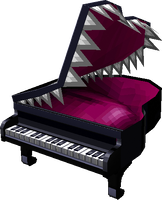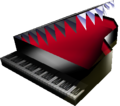Mad Piano
This article is a stub. Please consider expanding it to include any missing information. Specifics: Super Mario Kodansha manga and Super Mario-kun information
- This article is about the piano enemy from Super Mario 64. For the souvenir in WarioWare: Touched!, see Piano.
| Mad Piano | |||
|---|---|---|---|
 Model from Super Mario 64 DS | |||
| First appearance | Super Mario 64 (1996) | ||
| Latest appearance | Super Mario 3D All-Stars (2020) | ||
| |||
| |||
The Mad Piano[1][2] is a haunted piano enemy in Super Mario 64 and Super Mario 64 DS. It appears only in Big Boo's Haunt and protects a Red Coin found behind it. The Mad Piano looks like a normal baby grand piano and is harmless at first, but when the player approaches it, it begins to open and close its lid, revealing sharp teeth and, in the DS remake, a dark-purple tongue. The Mad Piano proceeds to chase and attack the player (while making the sounds that sound like someone hitting its keys) until they are far enough away. If hit by the Mad Piano, the player loses three wedges of health. The Nintendo Power Player's Guide erroneously states that the Mad Piano can be defeated.[1]
Though the Mad Piano has not appeared in any other game of the Super Mario franchise, some pianos similar to it have made an appearance. In Mario Party 2, during the night in Horror Land, a similar piano plays in a band with a violin and trumpet. In Mario Party 8, another similar piano appears on the board King Boo's Haunted Hideaway. In Luigi's Mansion 3, Amadeus Wolfgeist, the boss of The Great Stage, possesses his grand piano to attack Luigi in a similar manner to the Mad Piano, a connection to which Nintendo of Europe's X account made a reference,[3] but some of the grand piano attacks involve actions such as lunging upward in an attempt to land on Luigi.
Gallery[edit]
Screenshot from Super Mario 64 DS
Naming[edit]
The Japanese name for the enemy,「キラーピアノ」(Kirā Piano), implies a relationship with Bookend「キラーブック」(Kirā Bukku), another enemy introduced in Big Boo's Haunt. When Super Mario 64 was first released, its enemies were only fully localized within English and German guidebooks produced by Nintendo, in which this enemy was named "Mad Piano"[1] and Vampiano,[4] respectively. All other licensed paratexts referred to most enemies by informal descriptors, with the Mad Piano simply called the "piano".[5][6] This is followed suit on the 2007 online European Spanish guide for Super Mario 64,[7] as well as the Brazilian Portuguese and Spanish versions of Nintendo Today![8][9][10] All other non-Japanese versions of Nintendo Today! simply reused the name from the English Super Mario 64 guidebook, including the German version and with the exception of the Korean version, which used a transliteration of the Japanese name.[2][11][12][13][14][15][16]
Names in other languages[edit]
The contemporaneous name for each language is listed first. Subsequent names are listed in chronological order for each language, from oldest to newest, and have the media with which they are associated in the "Notes" column. Names exclusive to localizations of the Super Mario Bros. Encyclopedia are not prioritized due to concerns about circular reporting, and are only listed first for their respective languages if they are the only ones available.
| Language | Name | Meaning | Notes |
|---|---|---|---|
| Japanese | キラーピアノ[17][18][19][20] Kirā Piano |
Killer Piano; comparable to「キラーブック」(Kirā Bukku, "Bookend") | |
| Chinese (Traditional) | Mad Piano[11] | Unmodified from the English name | |
| Dutch | Mad Piano[12] | - | |
| French (Europe) | Mad Piano[21][13] | - | |
| Piano fou[22] | Mad Piano | Super Mario Bros. Encyclopedia | |
| German | Mad Piano[14] | - | |
| Vampiano[4] | Portmanteau between Vampir ("vampire") and "piano" | Super Mario 64 | |
| Italian | Mad Piano[23][15][24] | - | |
| Korean | 킬러피아노[16] Killeo Piano |
Killer Piano | |
| Spanish (Europe) | Killer Piano[25] | - |
References[edit]
- ^ a b c "Mad Piano / This baby grand can’t beat the band, but it can beat Mario. Just stay away from its smashing lid and biting keys. With a lot of effort, you can beat the piano, but you won’t get anything for doing so." – Pelland, Scott, and Dan Owsen (1996). Super Mario 64 Player's Guide. Redmond: Nintendo of America. Page 12.
- ^ a b "Mad Piano appears in this game. When you get close, it starts to move and tries to bite you." – Did you know? on Super Mario 64 (1 Dec. 2025). Super Mario Guess the Game!. Nintendo Today!. Retrieved 26 Dec. 2025.
- ^ NintendoEurope (November 25, 2019). If the haunted piano from Super Mario 64 still gives you nightmares, please keep scrolling.. Twitter (British English). Retrieved May 22, 2024.
- ^ a b Kraft, John D., Thomas Görg, and Marko Hein, editors (1997). Der offizielle Nintendo 64 Spieleberater „Super Mario 64“. Großostheim: Nintendo of Europe GmbH (German). Page 9.
- ^ Huyghues-Lacour, Alain, and Jean-Pierre Labro, editors (1997). "Super Mario 64" in le Nintendo Magazine officiel, 1. French. Page 91.
- ^ Ferri, Roberto (Apr. 1999). Official Nintendo Magazine, 6. Italian. Page 73.
- ^ Guías Nintendo (2007). Seek the 8 red coins (Las 8 endiabladas monedas rojas). Guía Super Mario 64 (European Spanish). (Archived April 18, 2024, 12:38:57 UTC via Wayback Machine.)
- ^ "Este jogo tem um piano que se move e tenta abocanhar quem se aproximar!" – Did you know? on Super Mario 64 (1 Dec. 2025). Super Mario Guess the Game!. Nintendo Today! (Brazilian Portuguese). Retrieved 26 Dec. 2025.
- ^ "En este juego aparece un piano que se mueve e intenta morderte cuando te acercas a él." – Did you know? on Super Mario 64 (1 Dec. 2025). Super Mario Guess the Game!. Nintendo Today! (Latin American Spanish). Retrieved 26 Dec. 2025.
- ^ «En este juego aparece un piano que se mueve e intenta morderte cuando te acercas a él.» – Did you know? on Super Mario 64 (1 Dec. 2025). Super Mario Guess the Game!. Nintendo Today! (European Spanish). Retrieved 26 Dec. 2025.
- ^ a b 「Mad Piano登場,一旦有人靠近就會動起來咬向對方。」– Did you know? on Super Mario 64 (1 Dec. 2025). Super Mario Guess the Game!. Nintendo Today! (Traditional Chinese). Retrieved 26 Dec. 2025.
- ^ a b "In dit spel verschijnt de Mad Piano, die je probeert te bijten als je te dicht in de buurt komt." – Did you know? on Super Mario 64 (1 Dec. 2025). Super Mario Guess the Game!. Nintendo Today! (Dutch). Retrieved 26 Dec. 2025.
- ^ a b « On y découvre l'ennemi Mad Piano, qui se met en mouvement et tente de dévorer quiconque s'en approche. » – Did you know? on Super Mario 64 (1 Dec. 2025). Super Mario Guess the Game!. Nintendo Today! (French). Retrieved 26 Dec. 2025.
- ^ a b „Hier taucht das Mad Piano auf, das sich bewegt und einen beißen will, wenn man ihm zu nahe kommt.“ – Did you know? on Super Mario 64 (1 Dec. 2025). Super Mario Guess the Game!. Nintendo Today! (German). Retrieved 26 Dec. 2025.
- ^ a b «Compare il Mad Piano, che si muove e cerca di morderti non appena ti avvicini.» – Did you know? on Super Mario 64 (1 Dec. 2025). Super Mario Guess the Game!. Nintendo Today! (Italian). Retrieved 1 Dec. 2025.
- ^ a b "다가가면 움직이며 물어뜯는 킬러피아노가 등장한다." – Did you know? on Super Mario 64 (1 Dec. 2025). Super Mario Guess the Game!. Nintendo Today! (Korean). Retrieved 26 Dec. 2025.
- ^ Takashi, Watanabe, Noriko Oketani, Yugo Nagasawa, and Junichiro Okubo, editors (1996). 『任天堂公式ガイドブック スーパーマリオ64』(Nintendo Kōshiki Guidebook – Super Mario 64). Tokyo: Shogakukan (Japanese). ISBN 4-09-102554-4. Page 4.
- ^ Noriaki, Kamiguchi, Kaisa Hitoshi, Teshiromori Nobuhito, Nagashima Kazutaka, Somoto Shitsuya, and Matsumoto Royo (2005). 『「スーパーマリオ64DS」タッチ!&ゲット!パワースター
攻略 ブック』. Tokyo: Kadokawa (Japanese). ISBN 4-8402-2960-0. Page 87. - ^ Sakai, Kazuya (ambit), kikai, Akinori Sao, Junko Fukuda, Kunio Takayama, and Ko Nakahara (Shogakukan), editors (2015). "Super Mario 64" in『スーパーマリオブラザーズ百科: 任天堂公式ガイドブック』. Tokyo: Shogakukan (Japanese). ISBN 978-4-09-106569-8. Page 85.
- ^ 「近づくと動き出してかみついてくるキラーピアノが登場。」– Did you know? on Super Mario 64 (1 Dec. 2025). Super Mario Guess the Game!. Nintendo Today! (Japanese). Retrieved 26 Dec. 2025.
- ^ Sawada, Yukio (2018). Super Mario Manga Adventures. Translated by Florent Gorges. Toulon: Soleil Productions (French). ISBN 978-2-30206-555-0. Page 28.
- ^ Ardaillon, Joanna, and Victoria Juillard-Huberty, editors (2018). "Super Mario 64" in Super Mario Encyclopedia. Translated by Fabien Nabhan. Toulon: Soleil Productions (French). ISBN 978-2-3020-7004-2. Page 85.
- ^ Sakai, Kazuya (ambit), kikai, Akinori Sao, Junko Fukuda, Kunio Takayama, Ko Nakahara (Shogakukan), and Marco Figini, editors (2018). "Super Mario 64" in Super Mario Bros. Enciclopedia. Translated by Marco Amerighi. Milan: Magazzini Salani (Italian). ISBN 889367436X. Page 85.
- ^ Sakai, Kazuya (ambit), kikai, Akinori Sao, Junko Fukuda, Kunio Takayama, Ko Nakahara (Shogakukan), and Marco Figini, editors (2025). "Super Mario 64" in Super Mario Bros. Enciclopedia (2nd ed.). Translated by Alessandro Apreda. Milan: Magazzini Salani (Italian). ISBN 979-1259575760. Page 85.
- ^ Sakai, Kazuya (ambit), kikai, Akinori Sao, Junko Fukuda, Kunio Takayama, and Ko Nakahara (Shogakukan), editors (2017). "Super Mario 64" in Enciclopedia Super Mario Bros. 30ª Aniversario. Translated by Gemma Tarrés. Barcelona: Editorial Planeta, S.A. (European Spanish). ISBN 978-84-9146-223-1. Page 85.





